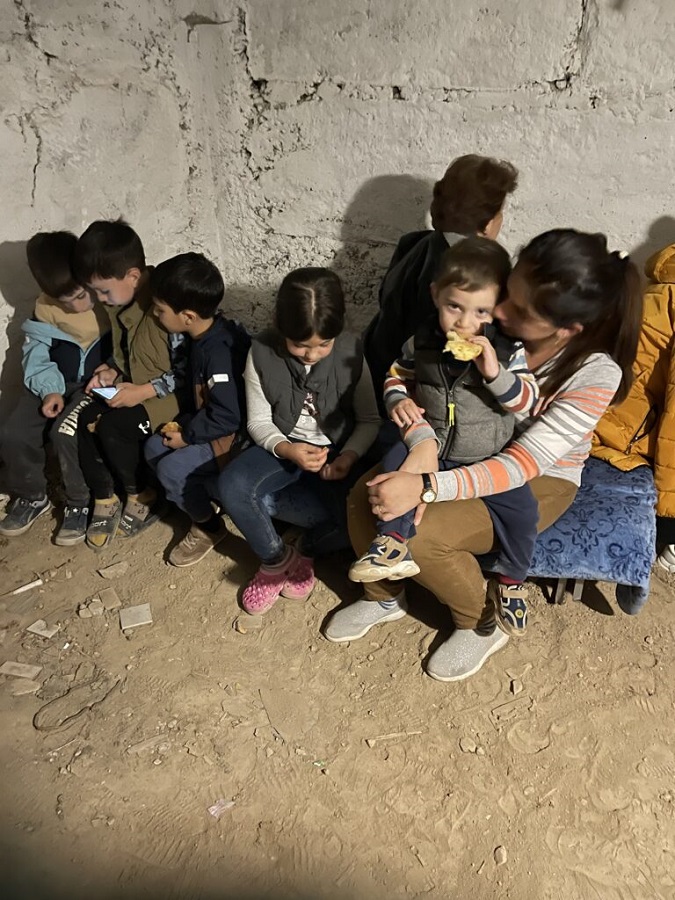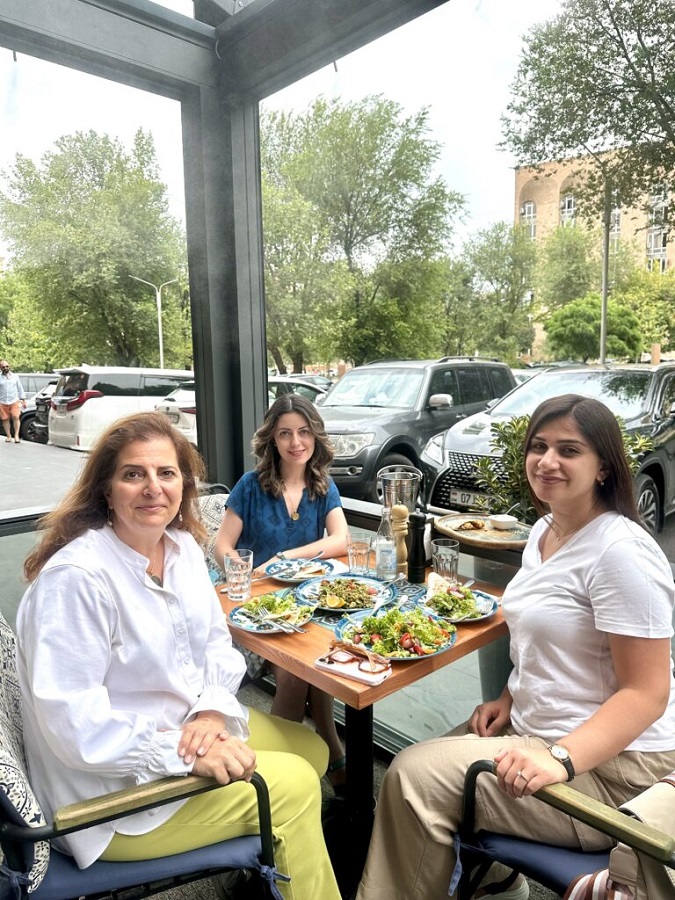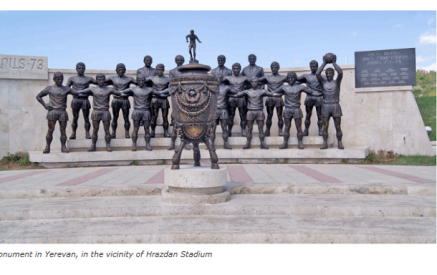The Armenian Weekly. One of the highlights of my summer trip to Armenia this year was reconnecting with two remarkable people whom I am lucky to call friends: Armine Mosiyan and Kim Hekimian. I collaborated with them back in April to organize the Armenian Genocide Remembrance Day program (see note) at Chhange (Center for Holocaust, Human Rights & Genocide Education). Since 1979, Chhange has been dedicated to educating students, educators and community members on the Holocaust, genocide and human rights and to empowering individuals to stand up against hate and injustice. One of Chhange’s regular events, held annually on or around April 24, is its Armenian Genocide Remembrance Day program. This year it was titled “Remembrance in a Time of Calamity” and drew attention to Azerbaijan’s brutal attack on Artsakh and the ethnic cleansing of its Armenian population in September 2023, which resulted in a catastrophic humanitarian crisis.
Planning this event was one of the most emotionally taxing experiences I’ve had since joining Chhange as its new executive director, yet also the most rewarding. The feedback we received from a variety of community members and educators was heartfelt and encouraging. Many appreciated the educational aspect of the program on a topic that is not widely discussed in the media or schools. The program brought together a distinguished historian of the Armenian Genocide, Dr. Khatchig Mouradian, and an eminent public health and nutrition expert, Dr. Kim Hekimian, in conversation with a refugee survivor from Artsakh, Armine Mosiyan. For many, hearing Armine’s testimony — a firsthand account from a young refugee who found the courage to trust Chhange’s audience with the details of her family’s experiences during war, blockade and exile, and who did not shy away from sharing her feelings merely six months after being forcibly displaced from her homeland — was an outstanding experience.
How did this program come to fruition?
I met Armine in January 2016, in Somerville, Massachusetts, where the Tavitian Scholars — a cohort of 15 mid-career professionals from Armenia with areas of expertise in international public policy, diplomacy, finance, national and global security, and law — were housed. Armine was going to study at the Fletcher School of Law and Diplomacy at Tufts University for a semester. I, on the other hand, was a doctoral student at Clark University and had just defended my dissertation proposal, which allowed me a brief break before I would embark on my archival journey in Saint Petersburg and Moscow. While Armine was curious why I had chosen to explore the experiences of Armenian Genocide refugees in the Russian Empire — such a heavy and complex topic — all I could focus on was the hand-drawn calendar on the wall of her room. I was surprised. Why was Armine counting the days? Why was she so anxious to return? She smiled gracefully and told me about her fiancé waiting for her in Stepanakert, Artsakh. They were planning to get married soon, have three sons and live their lives in “azat ankakh Artsakh” (free independent Artsakh). So they did…until September 2023.
Read also
Kim and I met in the spring of 2019, when I was invited to deliver the keynote at Sts. Vartanantz Armenian Apostolic Church’s Armenian Genocide commemoration event. Dr. Hekimian, an associate professor of Nutrition in Pediatrics and the Institute of Human Nutrition (IHN) at Columbia University Medical Center, was my ride to the venue. From the first moments of our conversation, it was clear I had met an exceptional person. Kim has been instrumental in helping the Republic of Armenia as a public health professional for many years and has visited Armenia every year since 1991. Here I was, speaking with a diaspora Armenian who not only had an excellent knowledge of my hometown Yerevan and Armenia in general, but was also proud of our country’s strengths and genuinely concerned about its challenges — an encounter I do not have often. It’s no surprise that she has been at the forefront of supporting the Armenian government with her expertise during the COVID-19 pandemic, the 44-day war and the forced displacement of over 100,000 Armenians from Artsakh.
While planning Chhange’s Armenian Genocide Remembrance Day program, I first reached out to my colleague Dr. Khatchig Mouradian. A lecturer in Middle Eastern, South Asian, and African Studies (MESAAS) at Columbia University and the Armenian and Georgian Area Specialist in the African and Middle Eastern Division at the Library of Congress, Khatchig is also Chhange’s long-time supporter and a friend. He prized the idea of a panel discussing the fate of Artsakh Armenians and was thrilled by the prospect of incorporating the perspective of a refugee survivor. Noting that he would join the program virtually from Australia, since Khatchig was scheduled to speak at three Armenian Genocide remembrance events in late April in Sydney and Melbourne, he agreed to serve as the historian expert on the panel. Soon, Kim, our second expert speaker, also confirmed her availability despite having a trip to Armenia scheduled for the night following our program. But the most challenging conversation was yet to come.
Will my story matter to them?
I had been trying to reach out to Armine for a couple of weeks, but because of the time difference and her busy schedule — taking care of her three sons while adjusting to a new residence and environment — our conversation was postponed several times. Finally, we scheduled a call. It was nighttime in Yerevan, and Armine was whispering. She had just tucked her sons into bed and had a few minutes to hear me out. When I asked Armine if she would be willing to share her family history and personal experience during the war, blockade and forced displacement with Chhange’s audience on April 24, she hesitated at first. She asked, “Do you think the audience would be interested in hearing my story? Will my story matter to them?” It took a few more follow-up calls to share what Chhange is about with Armine. She learned about our permanent exhibit “Journeys Beyond Genocide: The Human Experience,” which is based on personal histories shared by local Armenian, Jewish and Tutsi survivors and their families and descendants. Armine recognized that Chhange’s diverse audience of community members, students and educators appreciates and respects survivor speakers. Eventually, she agreed to give it a try. We were all set to go!
“Remembrance in a Time of Calamity”
On April 24, 2024, Chhange’s virtual program “Remembrance in a Time of Calamity” started with Khatchig’s reflections on the parallels between the Armenian Genocide and the forceful displacement of the Armenian population from Artsakh in 2023. For many Armenians, “this last episode of exile, destruction and loss of homeland was inextricably connected to the experience of the Armenian Genocide, its legacy and its long shadow.” Khatchig emphasized another important point: “The fact that in the region of Artsakh, where Armenians had lived for millennia, there is no single Armenian living today is testament to the scope of this loss.” Yet, he also spoke about resilience as an integral part of how Armenians survived, thrived and rebuilt their communities and reconstituted their homeland after the Genocide. “That generation, under those circumstances, with that level of total abject loss…If they could do it, we can do it now,” he concluded.
Armine continued the program, sharing publicly for the first time her story of loss, trauma and perseverance. Born and raised in Artsakh, Armine was four when she lost her father, Meruzhan Mosiyan, in the first Artsakh Liberation War. Now 34, Armine had seen four wars, survived a nine-month blockade and witnessed ethnic cleansing, as a result of which she, her husband and three sons were forcibly displaced from Stepanakert. Armine lamented, “First, I lost my father, then I lost my homeland…” Sharing her family history, Armine spoke of her father’s role in the war and his tragic loss. Yet she had a happy childhood, because she lived in Artsakh and was a proud daughter of a war hero.
Perhaps one of the most emotional moments for Armine and for the audience was when she talked about the blockade. She talked about the coupons for limited products in stores and shared a photograph of her sons gathered around the table in a dark room, eating “dinner.” Since there was no electricity or gas and there were no hot meals available. “The lines for bread were endless,” she recalled, and toward the end of the blockade, for several months no humanitarian assistance was allowed for the Artsakh Armenians at all. Armine described her feelings on the last day, in September 2023, right before she and her family had to flee their home: “And there I stood, trying to put our past, present, our life, our memories and our homeland in a suitcase and take it with me to nowhere, to the unknown future.” Yet she found the strength to conclude the presentation on a positive and hopeful note by saying that despite all this, she believes that they will return to Artsakh one day: “Church bells will toll again in Artsakh, heralding the return of Armenians to their homeland.”
Kim was the final presenter of the program. She talked about the public health crisis, international research on what happens to people who suffer war, blockade, assault and displacement and the story of the Artsakh refugees. Kim reminded the audience that Artsakh’s health services had suffered from the start of the 44-day war in 2020, since many hospitals were targeted during the bombardments and many physicians were killed. The blockade also represented a huge challenge for public health since the population faced a shortage of basic necessities and medicine. Pregnant women and infants lacked nutrition, and as Kim underscored, “undernutrition can have intergenerational consequences.” During the last several months of the blockade when no humanitarian assistance was available, it was fascinating to observe the resilience of the population. “The stories of how they helped each other were incredible,” Kim said. “People shared what they could and tried to prioritize the most vulnerable populations.” She concluded by sharing “evidence-based best practices for successful long-term outcomes for refugees,” addressing questions from community members involved in humanitarian assistance or willing to engage in it. Like her co-panelists, Kim expressed her confidence in a thriving future for Armine’s family and all the Artsakh refugees now residing in Armenia.
It goes without saying that the program was a success! The responses we received during the panel and afterward were filled with compassion, warmth, empathy and gratitude. Many expressed their gratitude for highlighting Armine’s story, giving her a voice and a platform to share her experiences.
It has been a year since….
That’s why I was excited that my trip to Armenia coincided with Armine and Kim being in Yerevan. I wanted to thank them in person, and I had questions. How was Armine, together with her family, adjusting to the new environment, neighbors and life away from her beloved Artsakh? I wanted to learn from Kim about the condition of those thousands of Artsakh Armenian refugees. How was the health system of a country as small as Armenia, with a population of less than three million, handling this crisis? What were some of the main challenges nearly a year after the exodus? What I heard was at times painful and disheartening, yet there was also a remarkable spirit of resilience and ingenuity, with many people coming together to support each other and find creative solutions to the challenges they face.
Speaking of resilience and ingenuity, Armine came to that meeting with gifts. She presented Kim and me with beautiful pendants featuring the angel from the Holy Savior (Ghazanchetsots) Cathedral in Shushi. The cathedral that once brought together thousands of people for wedding and christening celebrations, that in October 2020 was targeted by Azerbaijani rockets, a year after the exodus of Artsakh Armenians is now being dismantled and deliberately altered under the Azerbaijani government’s watch. Yet, each time I gaze at that angel from the Holy Savior, I hear Armine’s voice saying: “One day, church bells will toll again in Artsakh, heralding the return of Armenians to their homeland.”
Note: Chhange (Center for Holocaust, Human Rights & Genocide Education) is a nonprofit organization housed at Brookdale Community College in Lincroft, New Jersey. For more information, please visit Chhange’s website: www.chhange.org. You may view the discussed Armenian Genocide Remembrance Day virtual program (held on April 24, 2024) by visiting Chhange’s YouTube channel: www.youtube.com/@ChhangeBCC. The program was sponsored by the McOmber family in memory of Arsene B. Haroutunian.
Asya Darbinyan
In the main photo: Armine Mosiyan (right) with her son on the lap, sheltering from Azerbaijani rockets in a basement on September 19, 2023

























































